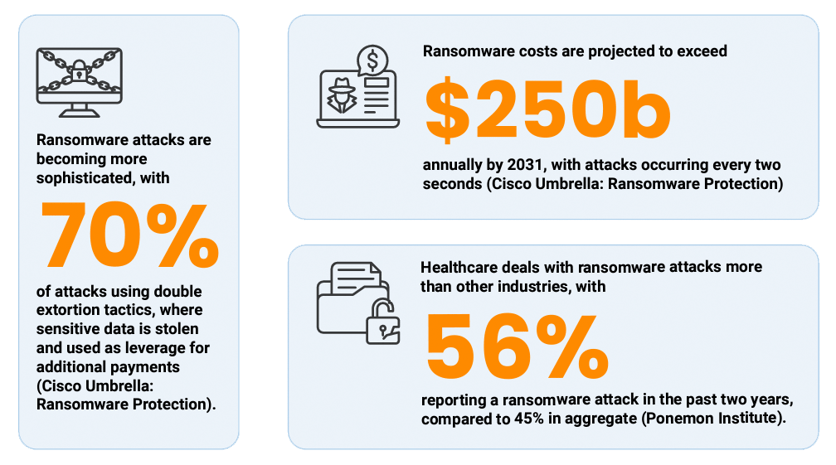Protect Your Healthcare Organization Against Cyber Threats
The State of Cybersecurity in Healthcare 2025: Insights You Need Today
Cyber threats in healthcare are escalating. From ransomware attacks to cloud vulnerabilities, protecting patient data and ensuring operational continuity has never been more critical. Saturn Business Systems, in partnership with Cisco, brings you the essential insights healthcare leaders need to navigate today’s complex cybersecurity challenges and prepare for tomorrow.

Key Trends at a Glance
Ransomware: A Growing Threat
- 70% of healthcare organizations reported ransomware attacks in the past two years, compared to 45% in other industries (Ponemon Institute).
- Ransomware costs are projected to exceed $250 billion annually by 2031, with attacks occurring every two seconds (Cisco Cyber Threat Trends Report).

The AI Paradox: Defense and Risk
- 92% of healthcare institutions plan to invest in AI and Machine Learning by 2025 (Gartner).
- While AI enhances threat detection, cybercriminals also use it to launch adaptive and highly targeted attacks.
Identity and Cloud Security Gaps
- Only 56% of healthcare organizations consistently implement Multi-Factor Authentication (MFA), leaving systems vulnerable to phishing and credential theft.
- Misconfigured cloud environments are among the top causes of breaches in healthcare IT.
Regulatory Challenges and Compliance
- 67% of healthcare organizations report challenges with evolving regulatory requirements like HIPAA, making proactive security measures essential.
Learn From Success Stories
 |
Dayton Children’s Hospital
|
 |
Frederick Health
|
Emerging Cybersecurity Trends
- Zero Trust Models: Proactively verifying every user, device, and system interaction.
- Cloud Security Focus: Emphasizing encryption, secure access, and monitoring for patient data safety.
- Ransomware Resilience: Enhanced incident response plans and stronger data recovery protocols.
Access the Full Report for Practical Solutions
The State of Cybersecurity in Healthcare 2025 report not only highlights key cybersecurity trends but also provides actionable steps to address them.
Here’s What You Can Do Now
1. Strengthen Your Ransomware Defenses:
Implement effective incident response plans, invest in real-time threat detection tools, and regularly test data recovery protocols to minimize downtime and financial impact.
- Why It Matters: Ransomware attacks are increasing in sophistication and frequency, targeting healthcare more than other industries. Acting now reduces your risk of operational disruptions and protects patient trust.
2. Close Identity and Cloud Security Gaps:
Enforce Multi-Factor Authentication (MFA) across all systems, review cloud configurations to ensure proper encryption, and conduct routine security audits.
- Why It Matters: Weak identity controls and misconfigured cloud environments are prime targets for cybercriminals. These steps fortify your systems against unauthorized access and data breaches.
3. Prepare for Regulatory Changes:
Build a compliance roadmap that includes regular reviews of HIPAA and other regulations, along with staff training on evolving requirements.
- Why It Matters: Regulatory penalties for non-compliance can damage both finances and reputation. A proactive approach ensures your organization stays ahead of changes while protecting sensitive patient data.
4. Leverage AI Securely:
Invest in AI-powered tools for anomaly detection, but also implement safeguards against AI-enabled attacks by monitoring unusual network activity.
- Why It Matters: AI is a double-edged sword—its ability to protect or exploit your organization depends on how you integrate and manage it.
Download the Full Report for a Strategic Edge
Gain detailed recommendations and step-by-step guidance tailored for healthcare organizations. Learn how to implement these strategies effectively and secure your organization for the future.
Looking for Personalized Support?
In collaboration with Cisco, Saturn Business Systems offers tailored cybersecurity consultations to address your organization’s unique challenges. Contact us today to schedule a consultation and start building a more secure IT environment.

